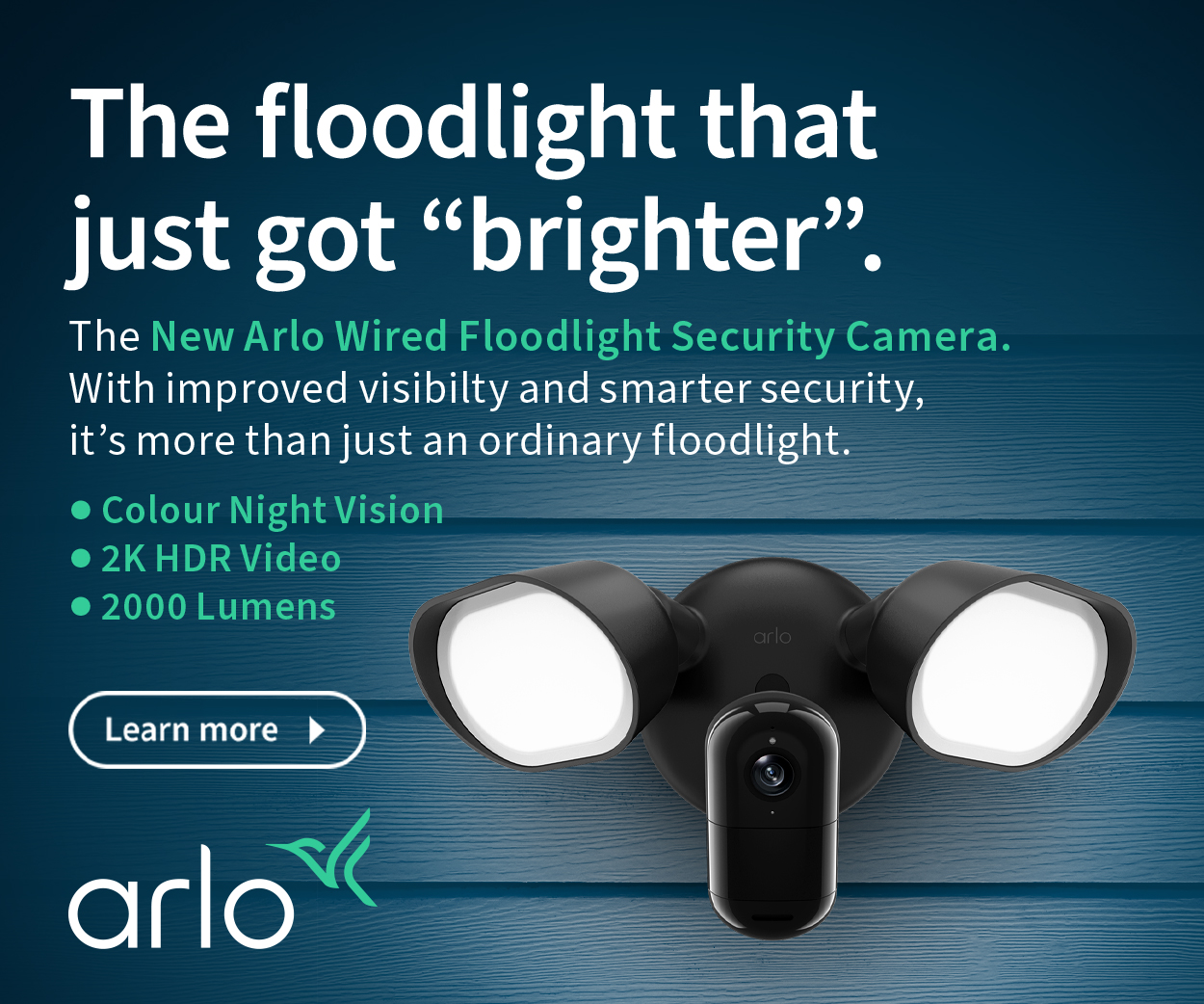ASUS Zenbook 14 OLED UX3405M 2024 – AI thinks for itself (computer)
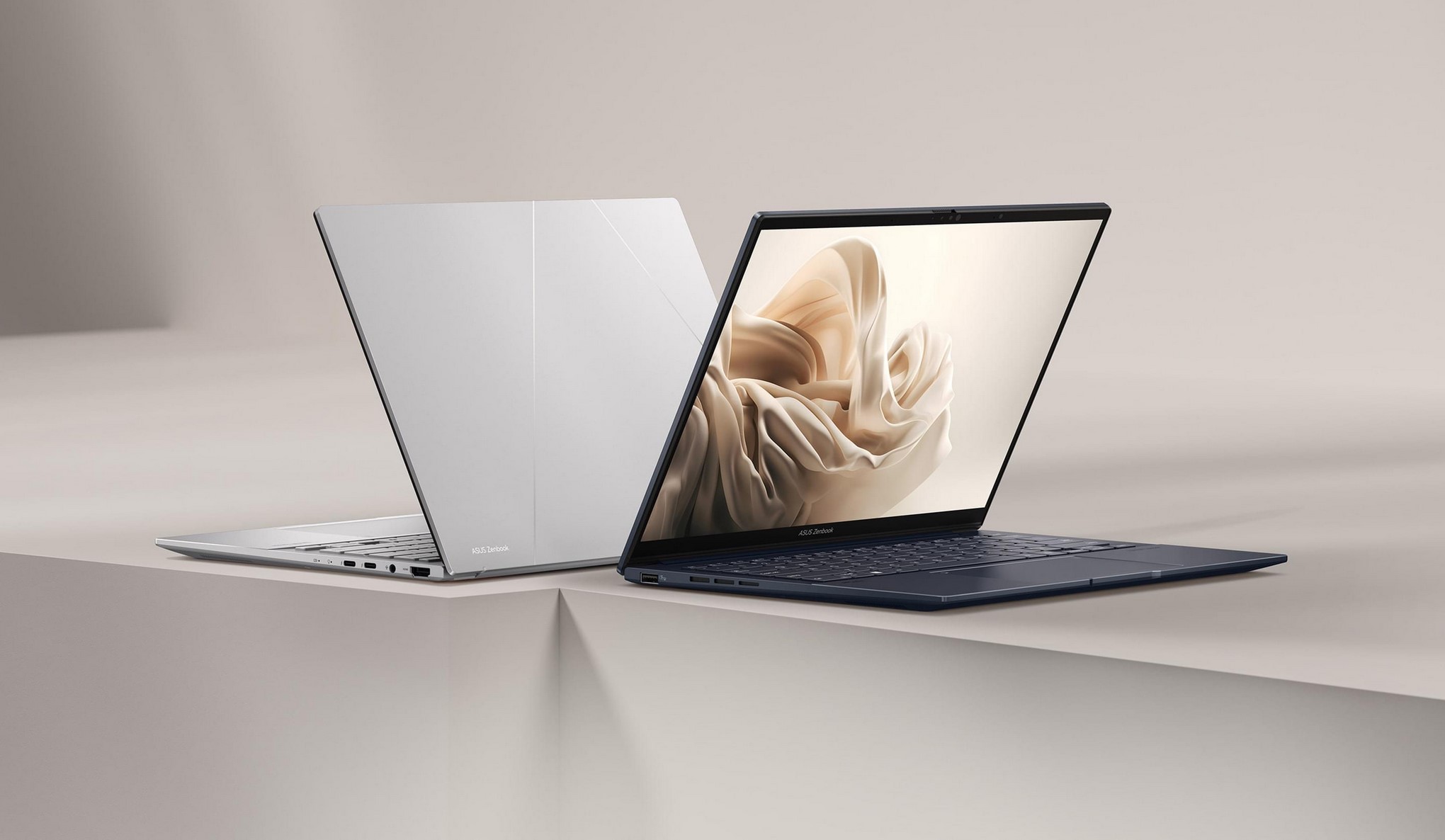
ASUS Zenbook 14 OLED UX3405M is one of the first AI laptops using Intel’s Core Ultra and Intel Arc Graphics. It is a subtle yet substantial upgrade over the 2023 model.
I want to start by defining AI. Why? Because 2024 is the year AI came to the humble toothbrush😁 and everything will claim some mystical AI advantages. Let’s call that AI-washing (as green-washing was the 2023 fashion).
AI, in this case, essentially means that the Intel Core Ultra has an AI NPU (numeric processing unit) and an Arc GPU to carry out some on-device AI processing. Add Windows 11 and its new CoPilot and AI-aware apps, and you’ll be taken to another level (whatever that is).
We have written an overview AI PCs are coming. What does that really mean? which we will continue updating as we understand more.
Australian Review: ASUS Zenbook 14 OLED UX3405M series
| Website | Product Page PDF Manual Service Manual |
| Price | From $2199 |
| From | ASUS Online and reputable computer specialists. |
| Warranty | 1-year ACL |
| Made in | China |
| About | Asustek Computer is a Taiwanese company that produces motherboards, graphics cards, optical drives, PDAs, computer monitors, notebook computers, servers, networking products, mobile phones, computer cases, computer components, and computer cooling systems. |
| More | CyberShack ASUS news and reviews CyberShack computer news and reviews |
New ratings in 2024
We use Fail (below expectations), Pass (meets expectations) and Exceed (surpasses expectations or is the class leader) against many of the items below. We occasionally give a Pass(able) rating that is not as good as it should be and a Pass ‘+’ rating to show it is good but does not quite make it to Exceed. You can click on most images for an enlargement.
We are also tightening up on grading. From now on, Pass, for example, means meeting expectations for the price bracket. We consider a Pass mark to be 70+/100 with extra points added for class-leading and excellence.

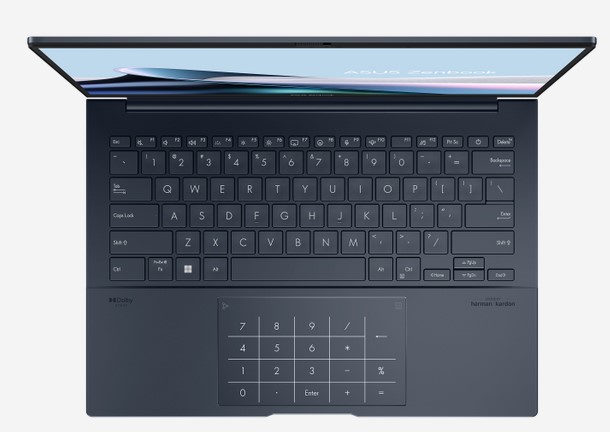


ASUS Zenbook 14 OLED UX3405M as tested $2399 but on sale, so shop around.
- Intel Core Ultra 7-155H
- 16GB LPDDR5X base price (32GB as tested)
- 1TB PCIe Gen 4 SSD
- 14” 2880 x 1800 (3K), 120Hz, 16:10 touch screen OLED under Gorilla Glass
- Wi-Fi 6E, BT 5.3
- 2 x TB4, 1 x HDMI 2.1 TDMS, 1 x USB-C 3.2 Gen 1 and 3.5mm 4-pole audio.
- Windows 11 Home
- 75W/h 4-cell battery and 65W USB-C charger
First Impression – Pass+
You, well, I, cannot help but lust over this svelte 31.24 x 22.01 x 1.49 ~ 1.49 cm x 1.28kg beauty. From its 14” almost bezel-less (87% screen-to-body) gorgeous colour OLED touch screen to its US MIL-STD 810H military-grade foggy silver chassis, it shows class and breeding. Add an excellent, oversized trackpad, typist-quality backlit keys and Windows Hello. I cannot think of anything else I could want.
Well, maybe 32GB of RAM and 2TB SSD😁. You could easily fit the SSD after the warranty expires, but the RAM is soldered to the motherboard, so if you want to make the best use of this, order the 32BG model. The service manual shows how easy repairing is, so it is a keeper.
This is a classic clamshell, alloy shell and chassis, with a 180°-fold-back flat screen.
Screen – Pass+
It uses a Samsung SDC419D ATNA40CU06-0 OLED panel with a digitiser overlay and glossy Gorilla Glass protection. This is the same screen used in other Zenbook 14 devices, which may explain why a laptop made in 2024 has a panel made in 2022. When you are on a good thing, stick to it!
The resolution is 2880m x 1800, 243 ppi (ASUS calls this 3K), 16:10, with an adaptive refresh rate of 48-120Hz and <6mm bezels.
ASUS calls this Lumia OLED, and if you cut through the marketing hype and look purely at the panel, you will see it is an excellent choice. Specs include (test results in brackets).
Tests
- Contrast: Infinite OLED pure black and white (Yes)
- Viewing angle: Excellent – no off-angle distortion, but you are meant to view it straight on anyway.
- PWM: It is TUV Rheinland Flicker-free certified but has some native PWM at 480Hz at screen brightness below 60%. DC Dimming is used for 60%+ and 120Hz refresh rates.
- Brightness: 400 nits of SDR brightness (412) and up to 600 nits of HDR Peak (616)
- VESA Display True Black 500 means it can peak up to 500 nits in a 2 to 10% window for HDR content (485). However, HDR10/Dolby Vision content needs more like 1000 nits, so it downscales to the panel’s capability.
- 10-bit/1.07 billion colours. Our tests show 8-bit + 2 FRC (frame rate control) that achieves the same effect.
- 100% of the DCI-P3 colour spectrum (99.7% for HDR content)
- 133% sRGB (100%+)
- Adobe RGB N/A (92.7%)
- Pantone validated (tested by Pantone to match the printed ink CMK PMS system)
- Delta E <1 (where <4 is good)
- Response: <1ms
- 10-finger multitouch and stylus input (Yes).
It has user-selectable modes. You must open the My ASUS app to change settings, as these override any Windows settings. There is also a Tru2Life video enhancement setting when viewing video content.
- Native default vivid colours (saturated and not accurate)
- sRGB – accurate for sRGB
- DCI-P3 – accurate for movies
- Display P3 – wider colour gamut
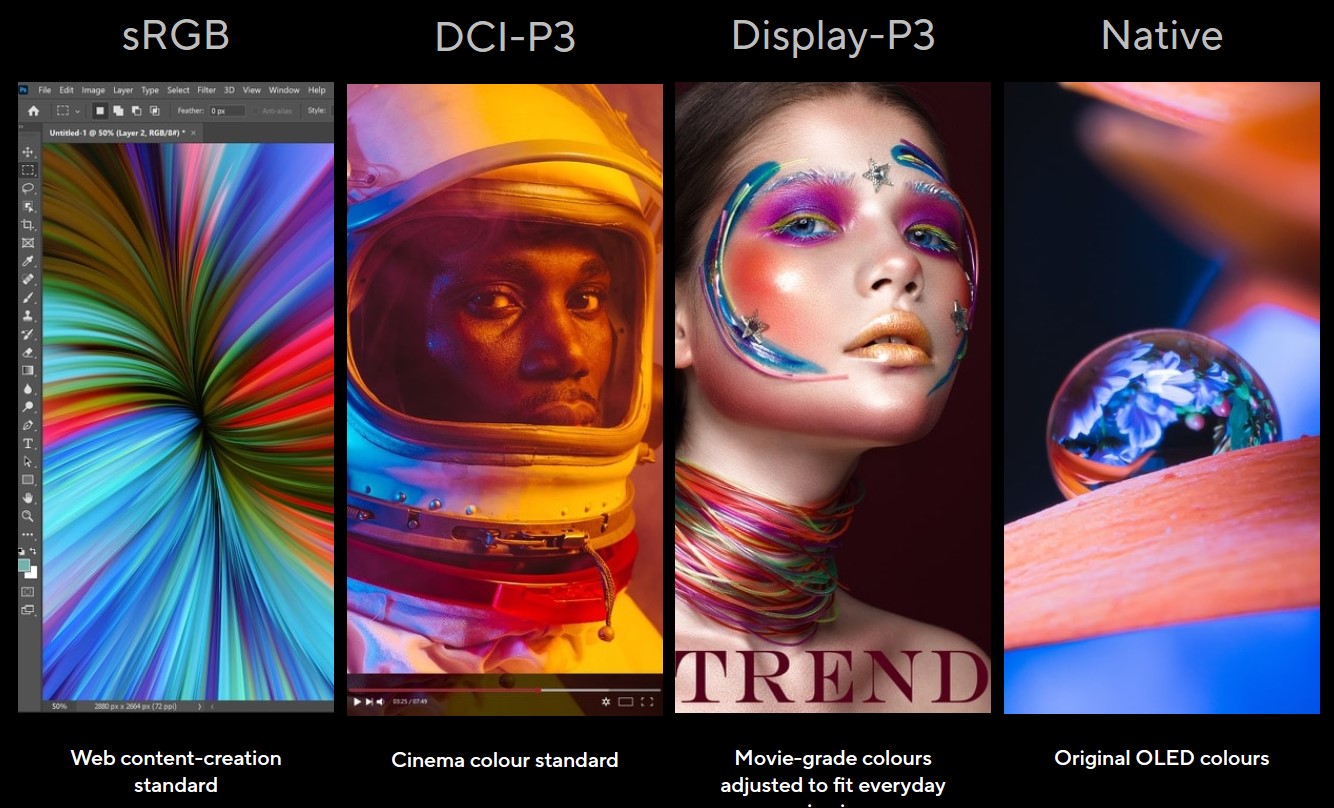
This is a panel that prosumer artists, designers, videographers, and editors can use and be relatively confident that the colours they specify are accurate. It is not a ‘Reference’ class – those panels cost several times as much.
HDR and Dolby Vision content – Pass
First, you must remember that a laptop’s OLED screen differs from a TV’s. TVs have a TV OS, custom processors, and smarts like intelligent upscale, object recognition, motion smoothing, and dimming zones (not for OLED) to make the image look great.
This supports HDR video streaming in Windows. That means the HDR content, including Dolby Vision, is downmixed to the panel’s brightness and colour gamut capabilities. You won’t see all the subtle HDR nuances in shadows and highlights. Similarly, multi-channel audio like PCM/Dolby Digital up to 7.1 and Dolby Atmos 5.1.4 is downmixed to 2.0 speakers.
That said, it is pretty good for a personal device – unless you know the difference.
ASUS Stylus Pen – Pass+
It has 4096 pressure levels, 5-530g pen tip force, a USB-C charge (30 minutes for 140 hours), four interchangeable pen tips (2H, H, HB, B), and Microsoft Pen Protocol MPP 2.0 technology.
We did not test this as we have done so many times. It is one of the better MPP 2.0 pens.
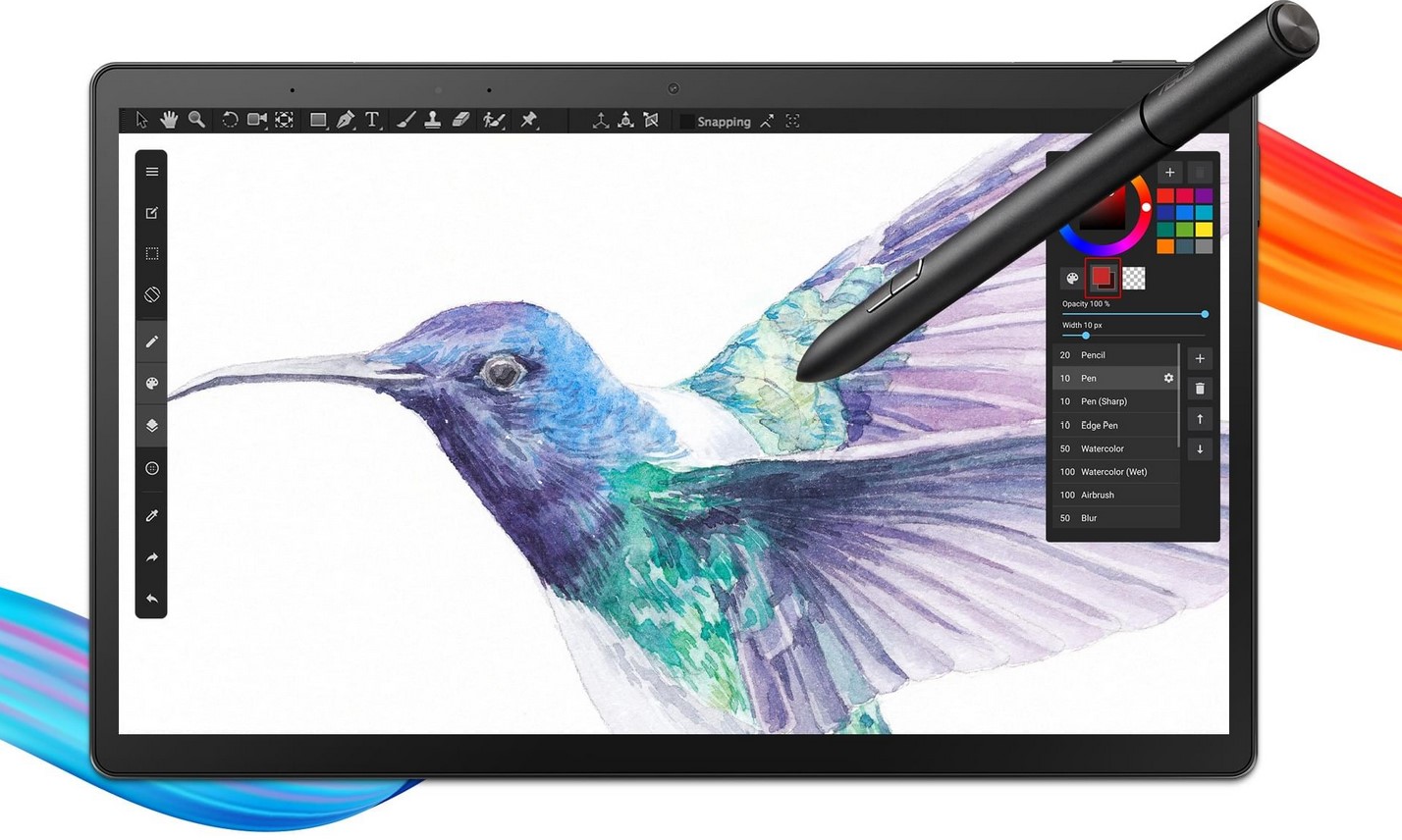
ASUS control software (not all tested)
Asus bundles software apps – many of which supersede Windows apps functionality.
MyASUS (click for overview)
- System Diagnosis
- Battery health charging
- Fan Profile
- Splendid
- Function key lock
- Wi-Fi SmartConnect
- Link to MyASUS
- TaskFirst
- Live update
- ASUS OLED Care
- AI Noise Cancelling
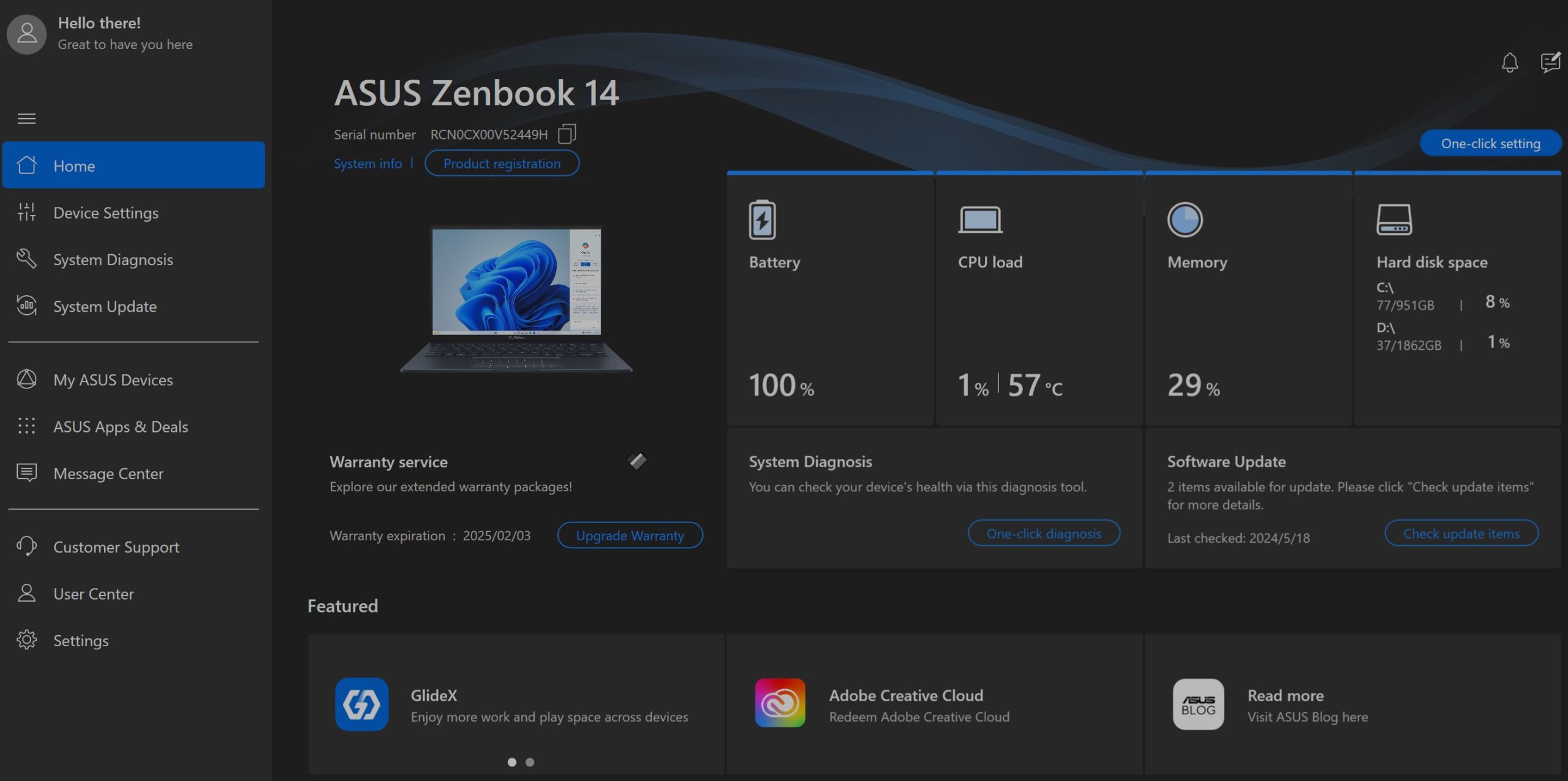

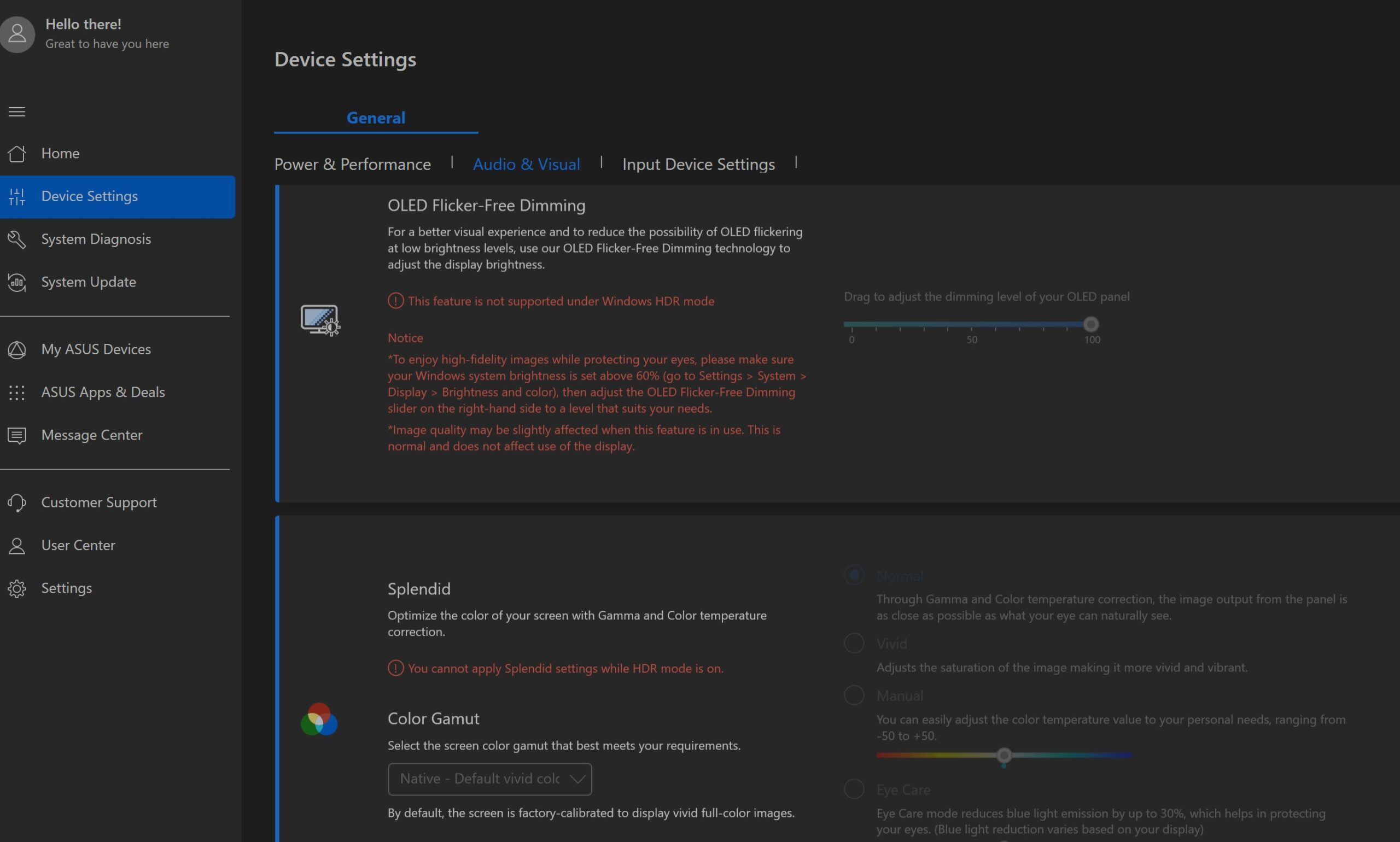
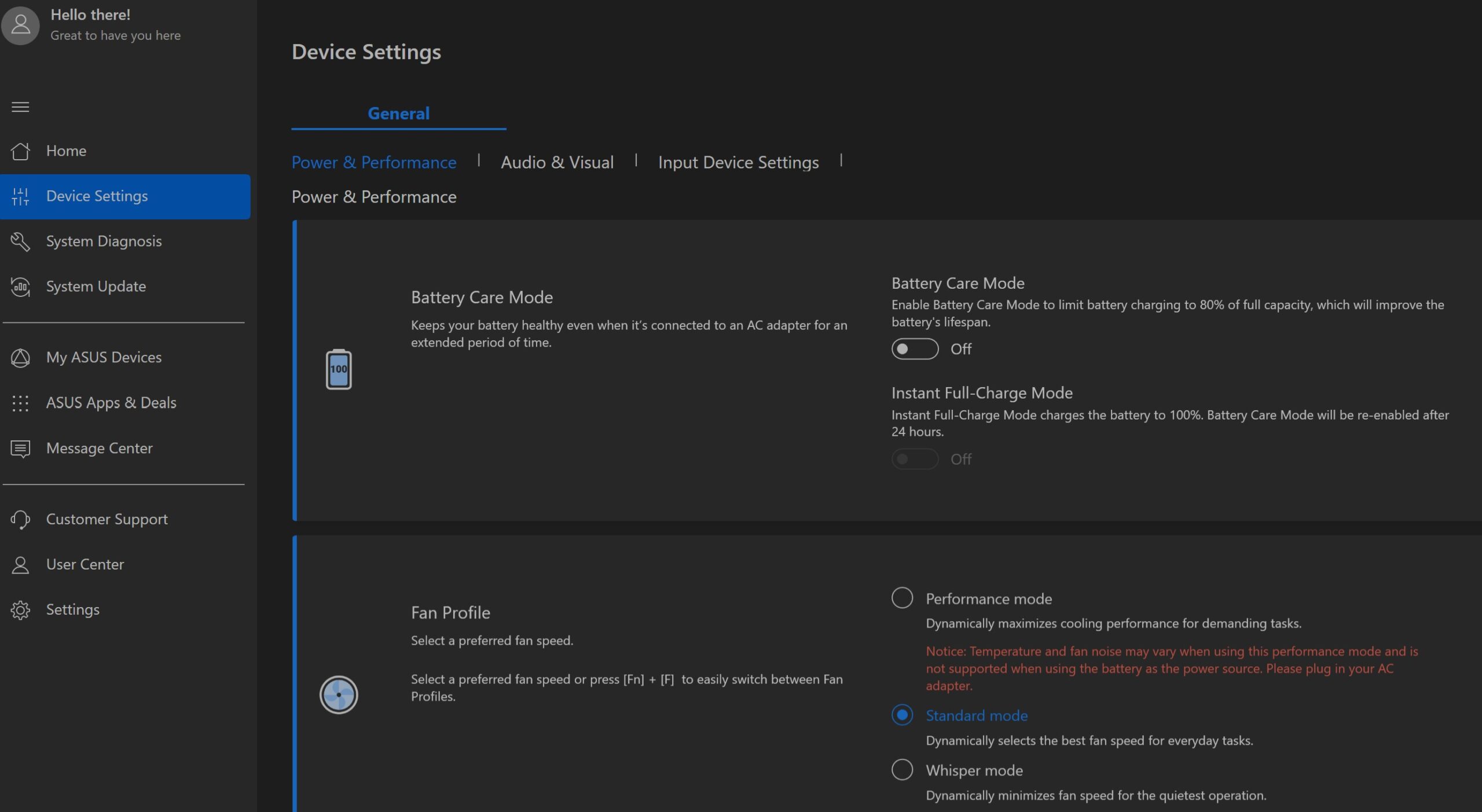
ScreenXpert 3.0 (click for overview)
Manages app windows across multiple displays. It also enables dual screens, an App Navigator, a Microphone switch, and flicking apps from one screen to another.
GlideX (click for overview)
It provides cross-device, cross-platform screen sharing, mirroring, and screen control. It can also manage file transfers, make/take phone calls via PC, share webcams, and provide remote access.
McAfee and Microsoft 365
Bloatware and trialware.
Intel Core Ultra Evo Processor – Pass+
You can buy a Core Ultra 5-125H, Core Ultra 7-155H (as tested) and Core Ultra 9-185H. According to Intel, the prime advantages are new AI experiences, better performance, faster graphics, and increased battery life.
We would not recommend the Ultra 5-125H unless you have lower expectations. The key differences between the Ultra 7-155H and 9-185H are: (7 specs first and 9 specs last)
- 7nm/same
- 16 cores/same
- 6/8/2 performance/efficient/low power cores/same
- 22 threads/same
- 4.8GHz maximum frequency/5.1
- 24MB Intel Smart cache/same
- Power base 28W/45W
- Maximum Turbo Power 115W/same
- AI OpenVINO, WindowsML, ONNX RT, DirectML, WebGPU/same
- Intel Arc graphics 2.25GHz/same 2.35GHz
- Four displays and HDMI 2.1 TDMS/same
- In-depth comparison here
- 5-125H Benchmarks
- 7-155H Benchmarks
- 9-185H Benchmarks
Benchmarks depend on system settings.
- Recommended (for the longest battery life but lowest SoC performance)
- Balanced (balance of battery versus performance),
- Best Performance (uses SoC fully without worrying about battery life).
Then, to complicate things, Wi-Fi, Bluetooth, and more can affect performance.
This is why manufacturers love to quote battery life as ‘Recommended’ (Best Efficiency) and performance specs as ‘Best Performance’.
ASUS Zenbook 14 OLED UX3405M 2024 tests
| Geekbench 6 | Single Core | Multi-core | OpenCL | Vulcan |
| Battery – Recommended | 1481 | 4850 | 26130 | 24452 |
| Battery – Balanced | 1520 | 9075 | 26547 | 25258 |
| Battery – Best Performance | 2308 | 11668 | 25157 | 24436 |
| Mains – Recommended | 2141 | 8538 | 35089 | 35408 |
| Mains – Balanced | 2381 | 12416 | 34514 | 36647 |
| Mains – Best Performance | 2403 | 12453 | 34316 | 35766 |
Fan noise: approx. maximum 40dB.
What this means
Geekbench is one of many synthetic benchmarks used to rate against other brands/models. The table shows the difference between the performance setting and battery versus mains power. the Core 7 has heaps of power.
We are not gamers. It appears that you can play most games at 1080p@60fps.
PC Mark Moden Office (Balance Power)

ASUS Zenbook 14 OLED UX3405M 2024 Disk Speed tests – Pass+
It has a WD PC SN560 SSDPNQE-1T00-1102 SSD. Its not as fast as expected but it is a PCIe NVMe Gen 4×4.
Crystal Disk Mark
CDM gives peak throughput.

CPDT
CPDT shows average sustained read and write speeds.
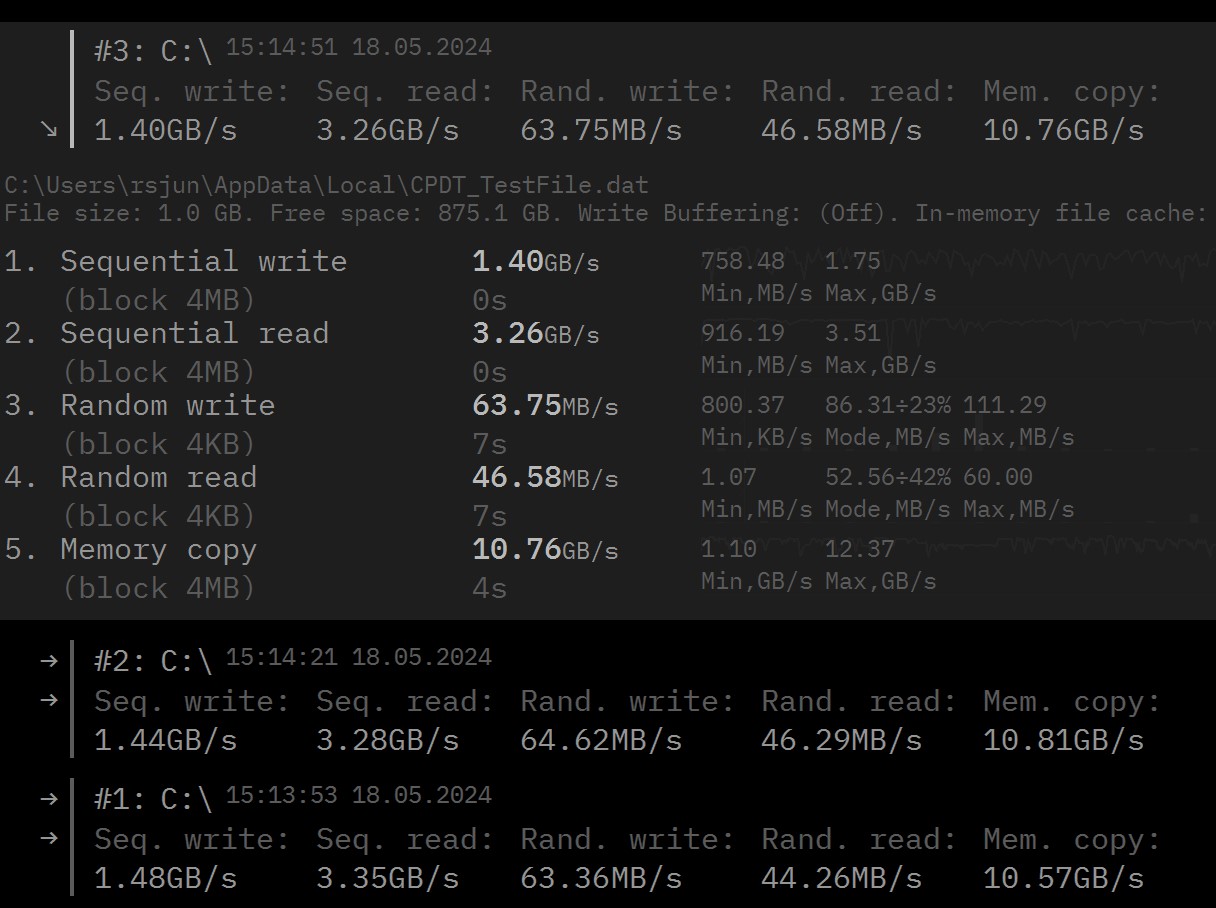
Black Magic DaVinci
Blackmagic shows video editing capability, which is a mix of processor, GPU, and disk.
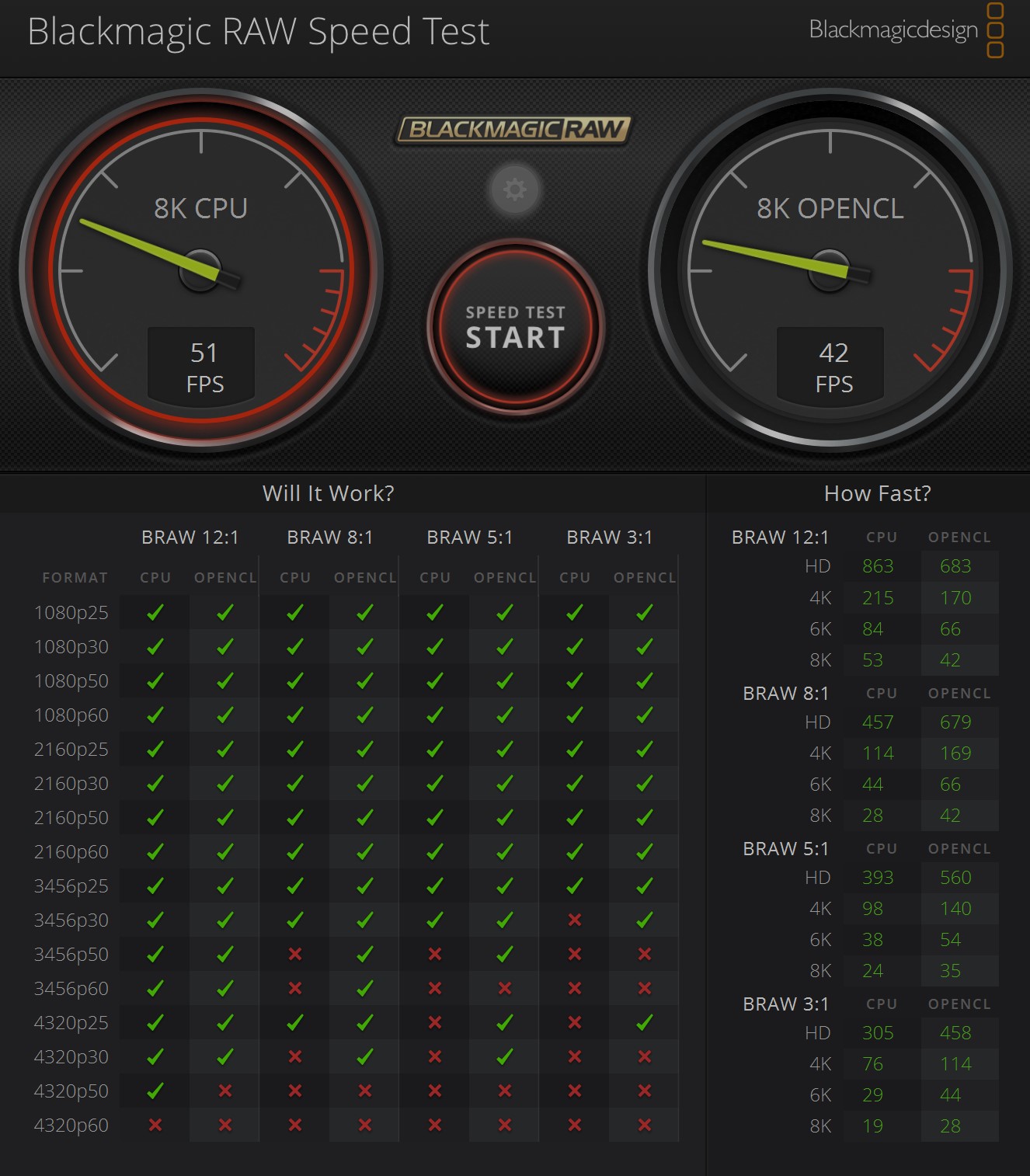
AS SSD
AS SSD shows a score that can be used to compare disk throughputs.
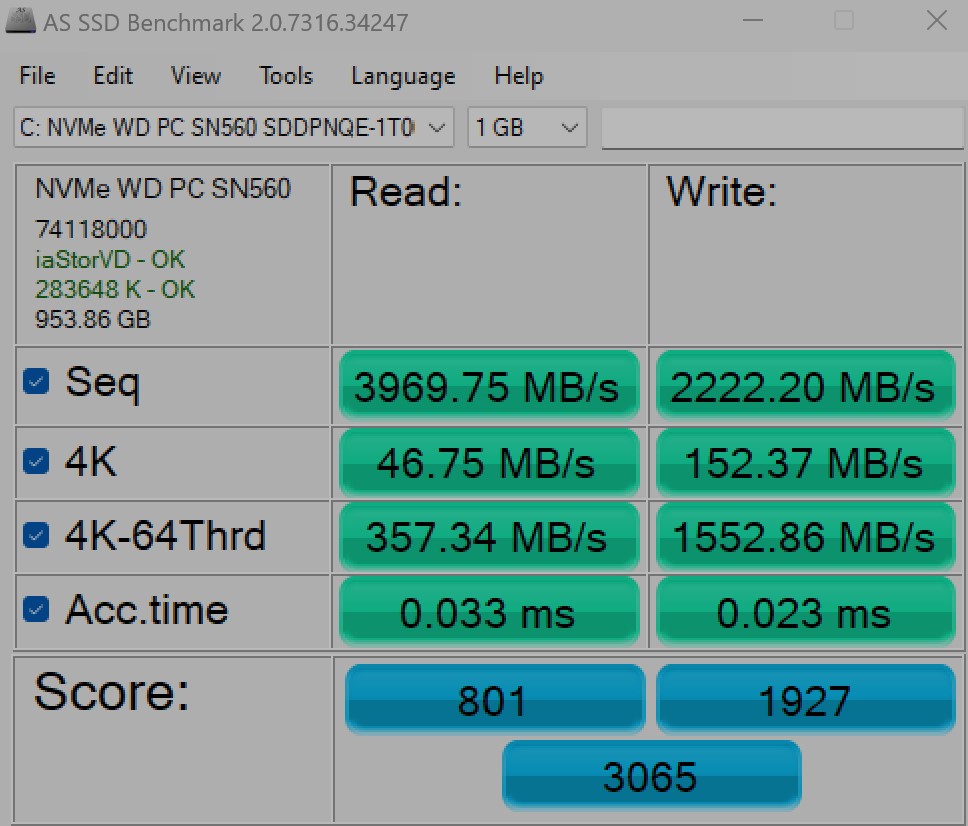
ATTO
ATTO is good for determining if the RAM or cache is too small to keep up sustained read/write. This is fine.
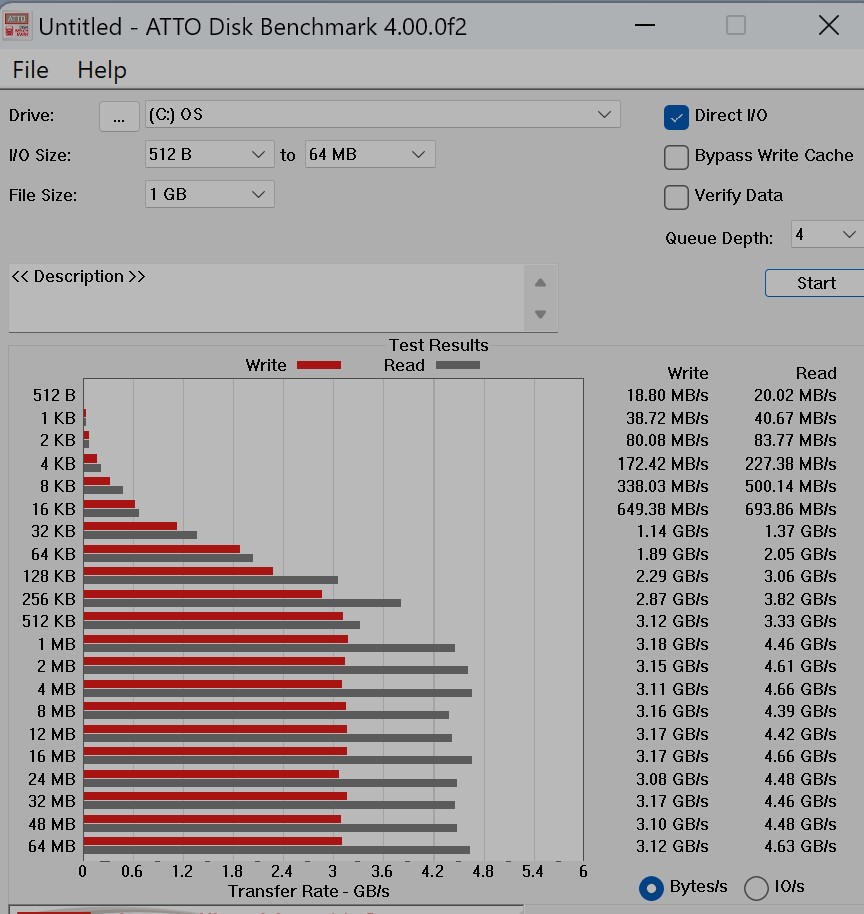
Ports – Pass+
- 2 x Thunderbolt 4 (40Gbps) ports backwards compatible with USB-4.0 (40Gbps), USB 3.1/3.2 Gen 1/2 (5/10Gbps) and USB 2 (480Mbps). Supports audio/video/data/upstream charge to 65W and downstream to 15W.
- USB-A 3.2 Gen 1 (5Gbps)
- 3.5mm 4-pole headphone/mic
- HDMI 2.1 TMDS (Transition Minimised Differential Signalling) is 18Gbps (not 48Gbps) and supports a maximum of 4K@60Hz, SDR, and 8-bit/16.7m colours. You can get higher resolutions from a Thunderbolt port (a maximum of two external monitors).
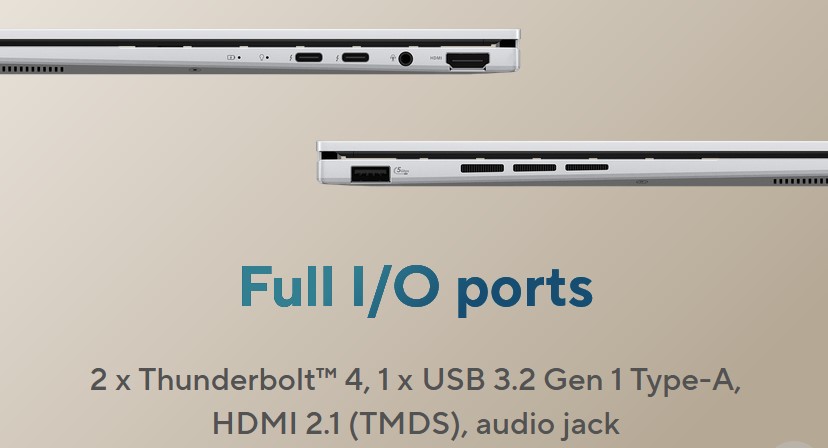
Port Expansion – Pass+
We tested it with a Belkin Connect Pro Thunderbolt 4 dock, and it supports upstream power, 2 x 4K@60Hz monitors and full speed from USB-A and USB-C ports.
We also tested a USB-C 3.2 Gen 1 dongle that supports 1 x 4K@60Hz and various USB ports. Just ensure it has a 65W passthrough.
Comms – Pass+
Wi-Fi 6E AXE uses an Intel AX211 M2 board that supports Bluetooth 5.3 and Windows Fast Pair. It connects at 2402/2402Mbps (maximum 2×2 speed) to the 6GHz network.
Battery – Pass+
It has a 75Wh 2S2P, 4-cell Lithium-Ion battery and a USB-C, 20V/3.25A/65W charger. You can use any PD or PPS charger. It tends to start charging at 19V/3A/57W (fast charge) and then progressively drops down as the battery fills. The battery is rated for 500 full charge cycles.
- PC Mark Modern Office Battery Test: is 12 hours and 13 minutes.
- Video Loop 1080p 50% volume/brightness: 14 hours 10 minutes
- Netflix streaming with Wi-Fi: 12 hours 55 minutes
- 100% load and full-screen brightness: 3 hours 12 minutes
- Charge time: 1.5 hours to 90% (battery life protection enabled).
Speakers – Pass
It uses a standard Intel Realtek setup capable of Dolby Atmos decoding and downmixing to its 2.0 left/right side-down-ported, Harman/Kardon-tuned speakers. They are inside the chassis near the external cooling ports on the sides near the front of the device.
The My Asus App overrides Windows settings. You must select the mode as required.
- Dolby Atmos (uses Dolby Access settings) – Default Dynamic
- Game
- Movie
- Music
- Voice
- Three custom presets
Sound – Pass

| Deep Bass 20-40Hz | Nil |
| Middle Bass 40-100Hz | Starts at 90Hz |
| High Bass 100-200Hz | Linear build to 200Hz |
| Low Mid 200-400Hz | Flattening to 500Hz |
| Mid 400-1kHz | Flat |
| High Mid 1-2kHz | Flat |
| Low Treble 2-4kHz | Flat |
| Mid Treble 4-6kHz | Flat |
| High Treble 6-10kHz | Dip to avoid harshness, then reasonably flat to 20kHz |
| Dog Whistle 10-20kHz | Reasonably Flat |
| Volume | 84dB |
| Sound Signature type | Bright Vocal (bass recessed, mid/treble boosted) – for vocal tracks and string instruments, but can make them harsh. |
| Soundstage 2.0 | The down/side-firing speakers have a wide sound stage – about 10cm on each side in a bubble around the screen. |
| Soundstage Dolby Atmos | If you use the Dolby Access app and enable DA, you get a quite good 3D spatial sound stage just above the screen, a little wider than the 2.0 soundstage. |
| Comment | Excellent sound. The 3.5mm jack delivers quality stereo and good volume. |
| BT 5.3 (headphones) | BT SBC codec is typical and crushes the mid-bass and high treble. Use a Creative BT-W3 and BT-W4 – add Qualcomm aptX and Hi-Def sound USB-A dongle for way better headphone sound. |
| Read | How to tell if you have good music (sound signature is the key – guide). |
Dolby Atmos (DA) – Pass
It has a DA decoder that downmixes the metadata of the 128 sound objects to the speaker’s 2.0 capability.
It widens the sound stage a little—maybe an extra 15cm on each side—but this is still a laptop. It also gives it some 3D vertical height just above the screen.
Be aware that DA is not always suitable for MP3 music, and we found it much better to disable it using the Dolby Access app unless you are watching a DA movie.
It works best with headphones.

Keyboard – Pass+
It has a 1.4mm, which is closer to the typist’s ideal. It has three levels of backlit and off. The letters are injection moulded and should last a long time (cheap notebooks use decals of reverse lettering paint).
The trackpad is huge, at 130 x 75mm, and has a nice slide feel. It can move the cursor from top right to bottom left in less than a swipe—no mouse is needed. It also has a light-up numeric pad.
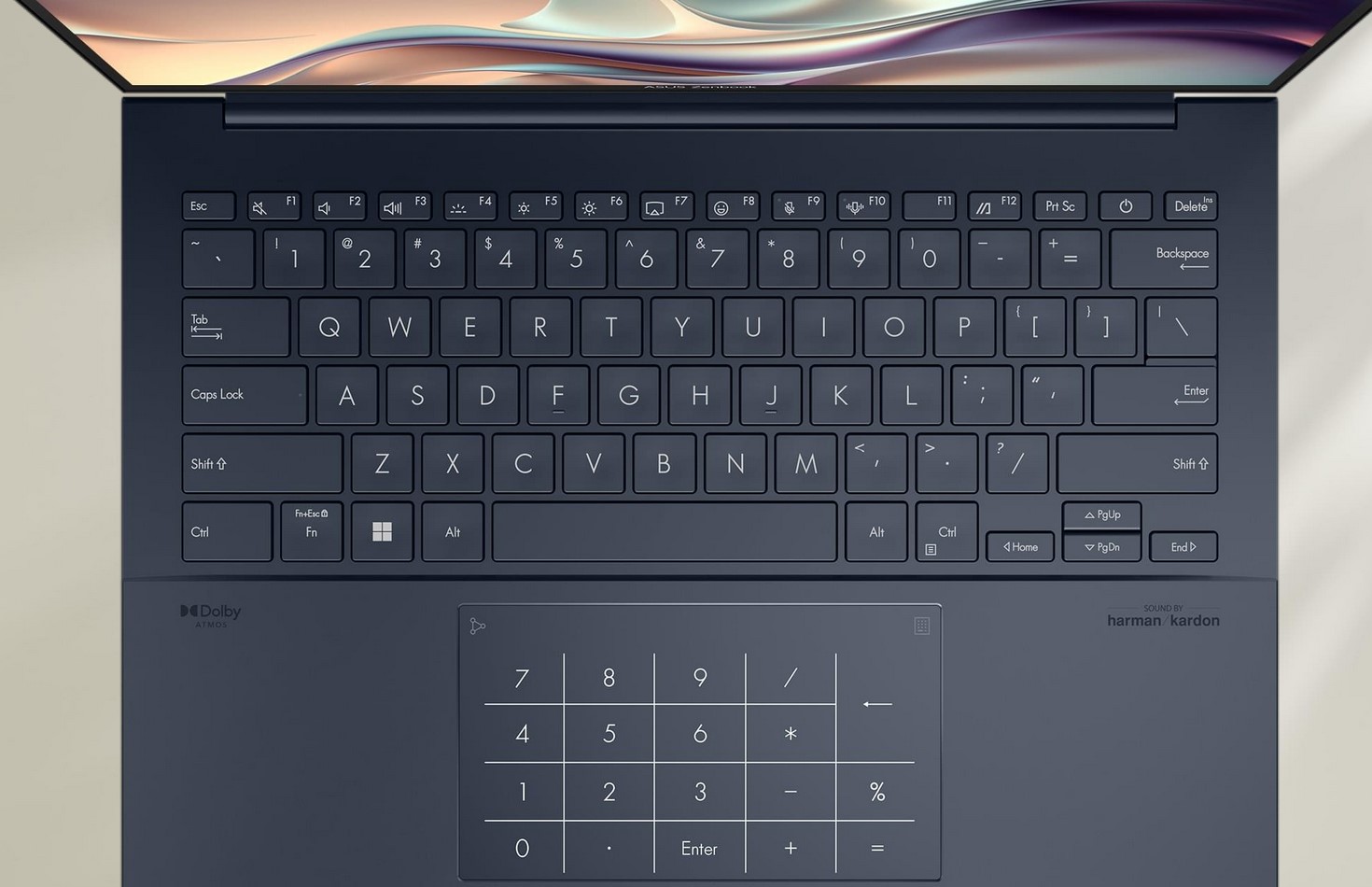
Camera – Pass+
It is a full HD 1080p webcam with IR Windows Hello login and dual mics for noise cancellation. It is acceptable for video conferences and has a privacy shutter.
My ASUS App allows for AiSence customisation.
- Lighting optimisation
- Background blurring
- Gaze correction
- Motion tracking
- Filters
Mics – Dual – Pass+
It has a dual mic array on the top screen bar. It can be used for AI Noise cancelling (or not), 360° mode, or single/multi-presenter/voice identification mode. The mics are effective and best used with Directional recording mode.
Build – Pass+
The build is to US MIL-STD 810H – it is pretty tough. There is no body or screen flex.
ASUS Zenbook 14 OLED UX3405M 2024 Maintenance and repairability – Pass
Torx screws are easily removed to allow for SSD replacement. Ram is soldered to the motherboard. We have no information on the availability of other parts outside the warranty, but you should be able to replace the battery, fan, screen, etc.
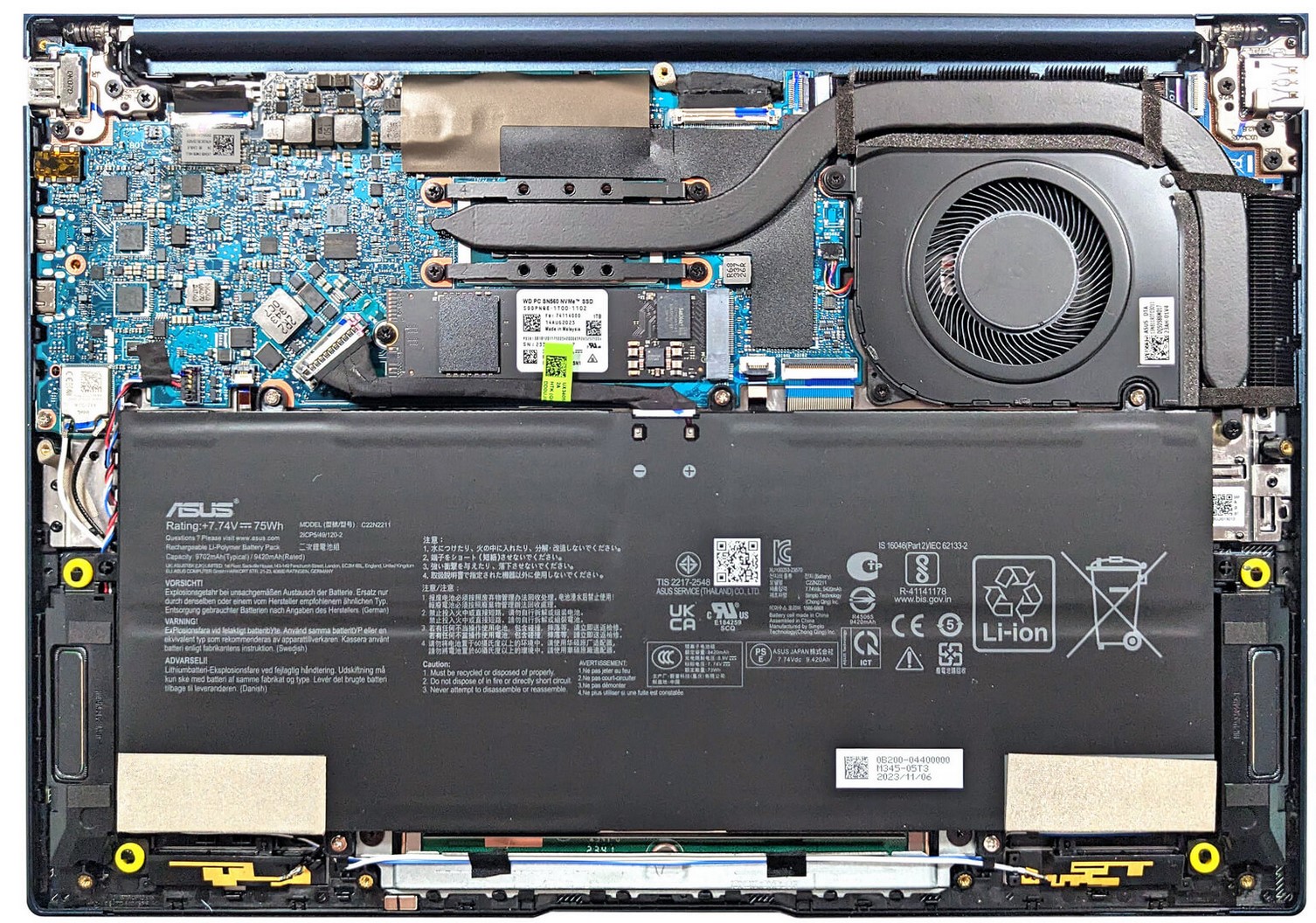
CyberShack’s view – ASUS Zenbook 14 OLED UX3405M is my definition of a most desirable laptop.
This review concerns ASUS’s use of the Core Ultra processor and AI capabilities. Sorry, ASUS and Intel, but I failed there and resorted to ‘speeds and feeds’.
Frankly, I don’t know how to measure AI’s impact. I get what it can do (theoretically), but it makes little discernible difference in daily use.
What I can tell you is that the aforementioned lust has not diminished after a couple of weeks of testing – damn, I may need to buy one.
Rating
Remember that the 2024 rating now use 7 as a base pass mark.
- Features: 90—Great 3K, 16:10, 10-bit/1.07 billion, 144Hz touch OLED protected by Gorilla Glass, excellent Intel Core AI CPU/NPU/GPU, decent typist keyboard/trackpad, and almost listenable speakers. There are no downsides.
- Value: 90—The 2024 series seems a bit cheaper, and this Core 7 is a value leader.
- Performance: 90 – Core 7 performed as well as expected.
- Ease of Use: 80 – It is Windows, which says everything. But we point out that its one-year warranty could be longer to prove ASUS’s commitment to its customers.
- Design: 85 – ZenBooks have a similar look and feel – a cut above the ordinary. Add MIL-STD 810H and it’s a winner.
ASUS Zenbook 14 OLED UX3405M 2024 Windows 11 laptop
From $2199Pros
- Excellent, bright, colourful OLED touchscreen
- 75Wh battery and 65W charging
- Great performance and graphics
- MIL-STD 810H
- Excellent keyboard and touchpad
Cons
- Not sure what AI does yet
- Speakers are not bad, but we don’t reward average
- Buy 32GB RAM if you can – 16GB leaves little room for AI
- Should have a longer warranty
Brought to you by CyberShack.com.au


